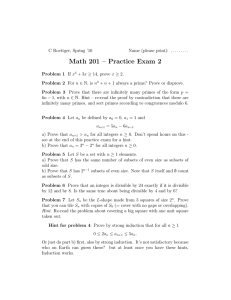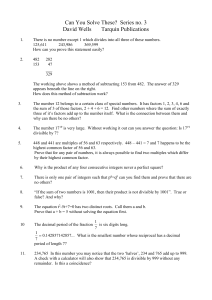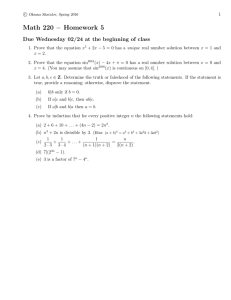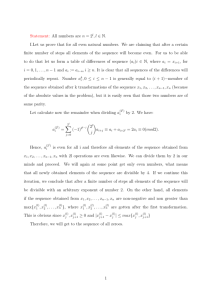Math 201 – Practice Exam 2 – solutions
advertisement
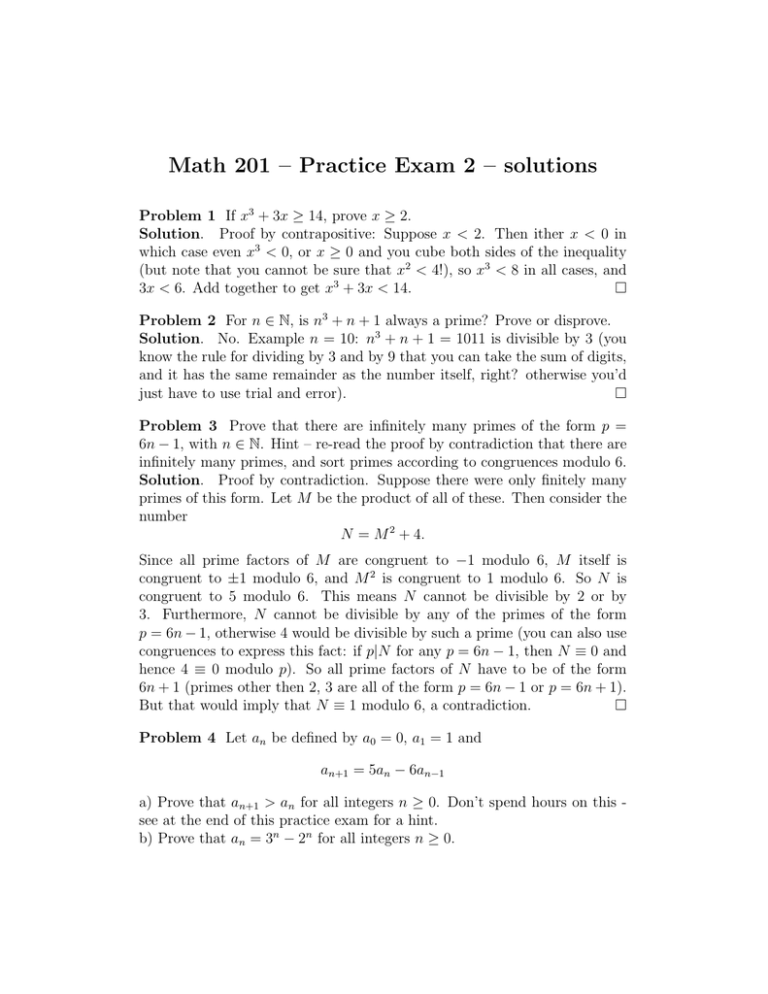
Math 201 – Practice Exam 2 – solutions
Problem 1 If x3 + 3x ≥ 14, prove x ≥ 2.
Solution. Proof by contrapositive: Suppose x < 2. Then ither x < 0 in
which case even x3 < 0, or x ≥ 0 and you cube both sides of the inequality
(but note that you cannot be sure that x2 < 4!), so x3 < 8 in all cases, and
3x < 6. Add together to get x3 + 3x < 14.
Problem 2 For n ∈ N, is n3 + n + 1 always a prime? Prove or disprove.
Solution. No. Example n = 10: n3 + n + 1 = 1011 is divisible by 3 (you
know the rule for dividing by 3 and by 9 that you can take the sum of digits,
and it has the same remainder as the number itself, right? otherwise you’d
just have to use trial and error).
Problem 3 Prove that there are infinitely many primes of the form p =
6n − 1, with n ∈ N. Hint – re-read the proof by contradiction that there are
infinitely many primes, and sort primes according to congruences modulo 6.
Solution. Proof by contradiction. Suppose there were only finitely many
primes of this form. Let M be the product of all of these. Then consider the
number
N = M 2 + 4.
Since all prime factors of M are congruent to −1 modulo 6, M itself is
congruent to ±1 modulo 6, and M 2 is congruent to 1 modulo 6. So N is
congruent to 5 modulo 6. This means N cannot be divisible by 2 or by
3. Furthermore, N cannot be divisible by any of the primes of the form
p = 6n − 1, otherwise 4 would be divisible by such a prime (you can also use
congruences to express this fact: if p|N for any p = 6n − 1, then N ≡ 0 and
hence 4 ≡ 0 modulo p). So all prime factors of N have to be of the form
6n + 1 (primes other then 2, 3 are all of the form p = 6n − 1 or p = 6n + 1).
But that would imply that N ≡ 1 modulo 6, a contradiction.
Problem 4 Let an be defined by a0 = 0, a1 = 1 and
an+1 = 5an − 6an−1
a) Prove that an+1 > an for all integers n ≥ 0. Don’t spend hours on this see at the end of this practice exam for a hint.
b) Prove that an = 3n − 2n for all integers n ≥ 0.
Solution. a) The secret is to prove more than the problem states. We claim
that for all n ≥ 1
0 ≤ 2an ≤ an+1 ≤ 5an
and we will prove this by strong induction. So we check a2 = 5 and a3 = 19
which works out. Then assume
0 ≤ 2an−1 ≤ an ≤ 5an−1
and we get from the recurrence formula
an+1 =
≤
an+1 =
≥
5an − 6an−1
(5 − 6/5)an ≤ 5an
5an − 6an−1
(5 − 6/2)an = 2an > 0
Now the original claim follows immediately from a2 > a1 > a0 and
an+1 ≥ 2an > 0
for n ≥ 2.
Alternative: do part b) first – see below!
b) We use strong induction over n. First, check this for n = 0, 1. Then the
induction hypothesis is that for k = 0, 1, . . . , n
ak = 3k − 2k
and we need to prove that this is true for k = n + 1, too. So we do
an+1 =
=
=
=
5an − 6an−1
5(3n − 2n ) − 6(3n−1 − 2n−1 )
by strong induction!
n−1
n−1
(15 − 6)3
− (10 − 6)2
factor out 3n−1 , 2n−1
3n+1 − 2n+1
laws of exponents
Not very satisfactory because it does not tell you how to discover that formula
- but once the formula is given, this kind of proof should be straightforward.
And once you have part b), you can use this to prove part a):
an+1 = 3n+1 − 2n+1
≥ 2 · 3n − 2 · 2n = 2an > an .
Problem 5 Let S be a set with n ≥ 1 elements.
a) Prove that S has the same number of subsets of even size as subsets of
odd size.
b) Prove that S has 2n−1 subsets of even size. Note that S itself and ∅ count
as subsets of S.
Solution. We use induction over n. For n = 1 this is true because |S| = 1
is odd and |∅| = 0 is even. Now assume the claim is true for some value
of n and any set with n elements. Let S be a set with n + 1 elements,
S = {a1 , . . . , an+1 }. Let S 0 = S − {an+1 }, so S 0 has size n. Let An , An+1 be
the set of subsets of even size of S 0 and S, respectively. Let Bn , Bn+1 be the
set of subsets of odd size of S 0 and S, respectively. We know
|An | + |Bn | = 2n
|An+1 | + |Bn+1 | = 2n+1 .
By the induction hypothesis,
|An | = |Bn |
|An | = 2n−1
and therefore
(we will do the proofs of a) and b) at the same time). Now we can take any
set from An and join an+1 to it, which will turn it into a set of odd size, so
an element of Bn+1 . We can also take any set from Bn as is, and it’s also an
element of Bn+1 (but does not contain an+1 ). We get all elements of Bn+1
that way, so
|An | + |Bn | = |Bn+1 | = 2n .
Either you do a similar argument on joining an+1 to elements (sets) in Bn ,
making them even, or you just use
|An+1 | + |Bn+1 | = 2n+1
(the total number of subsets - we showed this at the beginning of the semester,
IIRC. It would also be a nice short exercise in induction by itself). Both
arguments lead to |An+1 | = |Bn+1 |.
Problem 6 Prove that an integer is divisible by 24 exactly if it is divisible
by 12 and by 8. Is the same true about being divisible by 4 and by 6?
Solution. Proof of ⇒: Let n ∈ Z be divisible by 24. So n = 24m = 8 · (3m)
which proves that n is divisible by 8. Also, n = 12 · (2m) which proves that
n is divisible by 8.
Proof of ⇐: Let n ∈ Z be divisible by 12 and by 8. So
n = 12m = 8k.
Simplify to 3m = 2k. So 2|m, m = 2r and n = 24r, hence n is divisible by
24.
This is not true about 4 and 6: eg 12, 36, 60, and 72 are divisible by 4 and
by 6, but not by 24.
Problem 7 Let Sn be the L-shape made from 3 squares of size 2n . Prove
that you can tile Sn with copies of S0 (= cover with no gaps or overlapping).
Hint. Re-read the problem about covering a big square with one unit square
taken out.
Solution. Use induction over n. Obviously you can tile S0 with one copy of
S0 . Now assume that you can tile Sn with copies of S0 . Consider the shape
Sn+1 . By placing one copy of Sn at the center (where the three squares meet)
of Sn+1 and then filling in the rest, you can see that you can tile Sn+1 with
four copies of Sn (note that the area of Sn+1 is four times that of Sn , always
a good reality check). Since you can tile any copy of Sn with copies of S0 ,
you can also tile any shape made of copies of Sn , hence you can tile Sn+1 . Not part of the solution: Note that this proof does not just show tiling is
possible, it actually gives you a method for doing it. An alternative solution
would have been to place one copy of S0 at the center of Sn+1 , then cut Sn+1
into three squares of size 2n with one unit square taken out – each of these
can be covered by copies of S0 , like we did in class.
Hint for problem 4: Prove by strong induction that for all n ≥ 1
0 ≤ 2an ≤ an+1 ≤ 5an .
Or just do part b) first, also by strong induction. It’s not satisfactory because
who on Earth can guess these? but at least once you have these hints,
Induction works.


